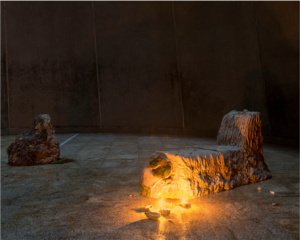When did ecology first come into your work?
At the School of Fine Arts in Bourges, I worked on brutalist, post-industrial architecture; then I made a study trip to Mongolia which connected me to the landscape and the natural elements – it was then that I realised I’d missed my rendezvous with the landscape up to that point. In much the same way as David Abram wonders how the earth came to be silent, this thinking was the driving force thereafter. Over the years, the subject of landscape has grown steadily. I wanted to bring a coherence between my interest in ecology, my everyday life and my work as an artist. Today I found an alignment.
For almost eight years, you have been organizing unique meals around edible urban plants… How did this idea come to you?
I had read Dead Cities by Mike Davies, which was about groups hunting for edible wild plants during post-war Berlin. I was curious to know if this kind of group still existed. I then met the urban picker Christophe de Hody, who organizes walks to discover edible plants in the city, so I suggested a meal using these plants in collaboration with him and the chef Virginie Galan. Together, we explored the sensitive and sensual relationship we have with food. The first meal lasted about two hours during which I read some scripts, from theoretical knowledge to more literary writing. Today I’m incorporating new tools to broaden the conversation. This work involves a great deal of research into the history of the relationship between man and plants. At the moment, I am leading a bread oven construction workshop at the Aubervilliers Laboratories. This year I will write a new meal, and will be accompanied by the philosopher Emanuele Coccia and the anthropologist Leo Mariani.
How do you integrate care and self-sufficiency into your work?
The reappropriation of other people’s savoir faire interests me. I am carried along upon the thoughts of Ivan Illich. There is a political dimension to developing a form of autonomy. It is necessary to have power over primary activities to stay alive: housing, food, health care… I got involved in the practice of ceramics to be able to make my tools. Subsequently, I familiarized myself with the techniques of raw earth pottery. There is a sensitive dimension to working hand-to-hand with these materials and as Tim Ingold says, in learning, we inherit a duty of transmission. The care practices I discuss have an essential relationship with basic elements like plants and water, which are found everywhere. These essential gestures can be questioned and open us up to other cosmogonies, to consider different ways of thinking. The idea is to construct stories and situations that take us out of a vision that is sometimes too anthropocentric.


Credits: Tiphaine Calmettes, Un sentiment de nature, installation at the exhibition Rituel·le·s at the IAC, Villeurbane, 2021 ©Thomas Lannes / Tiphaine Calmettes, Par le chant grondant des vibrations autour, exhibition at the Centre international d’art et du paysage de l’île de Vassivière, 2020 ©Rafaël Trapet, all rights reserved ADAGP
For your recent exhibition at the Centre international d’art et du paysage (in Limoges), you surveyed the island its situated on and proposed installations that encourage us to discover the energies of the site. How do you reveal the invisible, the pagan beliefs, the savoir faire?
These are questions that had already emerged in my personal exhibition at the La Galerie art center in Noisy-le-Sec, the perception of spaces from the point of view of feelings and esoteric beliefs. For the CIAP, I wanted to take all of the seeds I had sown in recent years and bring them all together into one great story. This place is in the middle of a magnificent landscape. The architecture is not forgotten even if at the entrance, the landscape is not present. So I played the frame out of frame, the inside out. It is a set formed from the experiences of the bodies that will pass through it. How to make this place a space for receptions or experiences? The objects presented in the exhibition are customary or practicable objects which we will use, or upon which we will sit. The taste dimension is also important. Each time there is a stimulis to the senses other than sight.
This exhibition is the result of several collaborations, different savoir faire. Most of the budget was allocated to paying the people I worked with, giving importance to the collaborations, which were numerous in this case.
Do you integrate eco-design into your projects?
I try to work as much as possible with materials that make sense to me, which is not easy because “noble” materials have a cost, which seems expensive compared to those used in industrial production. Apart from raw earth, ceramics like concrete have an environmental impact which is difficult to escape. However, I try to think of the production of objects and their life cycles over the long term, imagining re-using the materials in other contexts. The life cycle, and above all the life in the works, animates my practice. The immutable, conservable object seems to me obsolete, absurd. I seek to put movement and life into sculpture, to give objects a specific life form. And I explore how they can be carriers of a multitude of relationships, and in what ways they can also have a life themselves.
What is the function of performance in your practice?
The forms that appear to me are often linked to readings that will draw from various disciplines. It is an attempt to anchor questions in the real world. It makes me want to try things and confront the material or situations. Performance allows me to try relationships.
Pauline Lisowski
May 2021
Credits: Tiphaine Calmettes, view from the taste reading Il y avait des odeurs qui marchaient, Ygrec-ENSAPC, Aubervilliers, 2020 ©Nathalia Chatzigianni
Find all the articles from Impact Art News n°30 – May 2021
To subscribe to Impact Art News (free) : here

